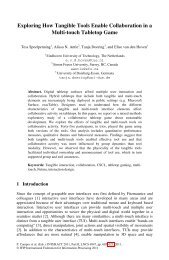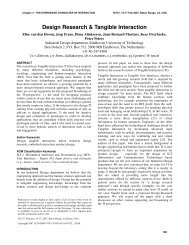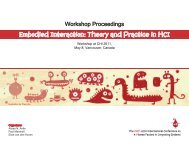Sissy - Elise van den Hoven
Sissy - Elise van den Hoven
Sissy - Elise van den Hoven
You also want an ePaper? Increase the reach of your titles
YUMPU automatically turns print PDFs into web optimized ePapers that Google loves.
OUR STUDY<br />
In their kitchen manifesto, Bell and Kaye (2002) advocate<br />
a kitchen/technology relationship that draws on and<br />
learns from the rich cultural history of the kitchen as a<br />
place for living and above all, a focus on those who<br />
experience the space, rather than the resi<strong>den</strong>t<br />
technologies.<br />
In our approach, we studied a set of videos published on<br />
YouTube to understand particular nuances of the activity<br />
of people cooking together. We used qualitative content<br />
analysis on a set of 169 YouTube videos comprising the<br />
search results for the keyword phrase “cooking together”<br />
on 15 November 2010, sorted by rele<strong>van</strong>ce (see Figure<br />
1). Several of the resulting videos were clearly not related<br />
to the research area of people cooking together but were<br />
poems, music clips or gaming videos with misleading<br />
keywords. These were discarded from the analysis<br />
process as well as any duplicates, leaving a final set of 61<br />
videos to be analyzed in depth.<br />
Figure 1. Sample scene from “Cooking Together” video<br />
From this analysis the following set of categories were<br />
induced: video production, cook expertise, relationship of<br />
cooks, genre, content, intended audience, skill level,<br />
location, background story, mood, food role, people role,<br />
motivation. This was then used to make a content map of<br />
the videos based on their attributes within these<br />
categories. From this content map, six main types of<br />
videos were i<strong>den</strong>tified: family life; family cooking;<br />
celebrities cooking; amateur cooking show; professional<br />
cooking show; documentary; educational video and<br />
advertising. A representative video from each of these<br />
groupings was then “transcribed” in detail, using a map<br />
form similar to Kendon’s diagramming technique for<br />
recording F-formations at a birthday party (p. 228). On<br />
the map we recorded patterns of physical movement and<br />
bodily relationships of the cooks to each other and to the<br />
“remote person” (in respect to the camera view). Each<br />
frame was time stamped with the video time count and<br />
recorded a newly established position of individuals and<br />
the position of the camera and field of view. The cooks<br />
were shown as ovals with two lines extending to show<br />
their transactional segment, making visible where they<br />
intersect to create an o-space. Paths of movement through<br />
spaces and focal artefacts were also documented.<br />
Showing the virtual position of the imagined viewer made<br />
it possible to i<strong>den</strong>tify their participation in F-formations.<br />
32<br />
Figure 2. F-formation Map of YouTube video: 57<br />
These maps were then used to i<strong>den</strong>tify the following: the<br />
F-formation system between collocated cooks; the Fformation<br />
system between the viewer (the camera) and<br />
the cooks; and the perceived distance between the viewer<br />
and the person in focus using the distance classifications<br />
from Hall (1966). These i<strong>den</strong>tifications where then<br />
studied in respect to activities being performed by the<br />
cooks, the positions of the cooks in respect to each other<br />
and the position of the camera in respect to the activity in<br />
focus and the cooks. I<strong>den</strong>tifying F-formations highlighted<br />
situations where an o-space was formed by participants’<br />
transactional segments (including the viewer) and any<br />
focal artifacts (i.e. the food being prepared, the kitchen<br />
utensils) located in that o-space. The proxemic coding<br />
was used to correlate the intimacy or otherwise of the<br />
bodily interactions between cooks (including the “virtual”<br />
viewer).<br />
FINDINGS<br />
Our analysis focused on the location and composition of<br />
F-formations (Kendon, 1990) in the kitchen between<br />
people cooking together and a “virtual” viewer. Focusing<br />
the digital ethnography on F-formations allowed us to<br />
i<strong>den</strong>tify situations when interaction with the camera, the<br />
cooking partner, and/or both, supported inclusion in the<br />
social encounter for all. That is, when an F-formation<br />
exhibited an o-space formed by all participants’<br />
transactional segments (cooks and viewers). In both cases<br />
the transactional segments intersected on the activity<br />
being performed and hence an F-formation system was<br />
created and maintained for the duration of this activity.<br />
The formation of the o-space confirmed the viewer’s<br />
participation in the activity of cooking together. In any<br />
digitally “blended” cooking space, that is the kind of<br />
experience that should be supported using technology.<br />
Using the spatial maps of the human-food interaction<br />
helped us to i<strong>den</strong>tify a new kind of spatial pattern, not<br />
previously classified by Kendon (1990), that formed an<br />
important part of the cooking interaction when wanting to<br />
include others in the activity. We called this F-formation<br />
spooning. From the videos it can be seen that spooning is<br />
an important part of showing and sharing progress during<br />
a cooking activity. It is also an intimate interaction, in<br />
respect to Hall’s (1966) proxemics. People come from<br />
behind a person, both to assist in an activity being<br />
performed by the front person (e.g., how to chop food in a<br />
particular way, how to add an ingredient) and to see what<br />
a person is doing with a particular artefact or piece of<br />
food from the perspective of the front person (e.g.,



![Download 1.8 MB [pdf] - Elise van den Hoven](https://img.yumpu.com/18078175/1/190x245/download-18-mb-pdf-elise-van-den-hoven.jpg?quality=85)

![Download 0.2 MB [pdf] - Elise van den Hoven](https://img.yumpu.com/18078145/1/182x260/download-02-mb-pdf-elise-van-den-hoven.jpg?quality=85)
![Download 0.1 MB [pdf] - Elise van den Hoven](https://img.yumpu.com/18078125/1/190x146/download-01-mb-pdf-elise-van-den-hoven.jpg?quality=85)
![Download 1.9 MB [pdf] - Elise van den Hoven](https://img.yumpu.com/18078041/1/182x260/download-19-mb-pdf-elise-van-den-hoven.jpg?quality=85)

